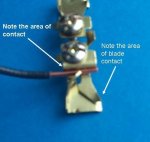I don't do it even on switches.
I don't go out and project my concerns on back stabs. Ive seen enough relative to side screws (yes Ive seen those fail too) to reach the conclusion that back stabs are far more failure prone.
That's sort of subjective and relative, though.
I've pulled receps and switches out of the wall, finding the backstabbed wires pulled out. But I've also pulled them out to find screws are loose, too.
Do those loose screws always indicate installer error, or do you suppose they loosen over time? Ive seen plenty of loose screws on breakers and neutral bars too. Screws loosen over time, and loose is loose
As for receps, the blade insertions get loose before the backstabs, imho
The remedy is proper maintenance, which I suggest to as many customers as I can. I suggest a thorough maintenance call every 6-8 years, and whole house device replacement after 20 years.
Even if backstabs were far more prone to failure, should that necessarily translate into an aversion to the use of them?
Gas furnaces are far more prone to failure than an electric furnace, especially as the years go by. Maybe gas furnaces should be outlawed?
Asphalt roofs are far more prone to failure than slate roofs, especially as time goes by.
Wood fences fail way before wrought iron
Stuff wears out, that's just a fact of life. And compared to other things around the house, people are negligent when it comes to electrical maintenance. Not our fault, and we're not gonna save the world by refusing to backstab


